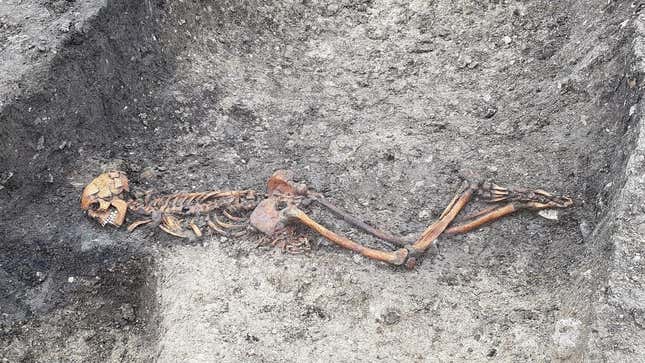
Preparatory work for a high-speed rail project in Britain has resulted in some interesting archaeological discoveries, including a 2,000-year-old skeleton thought to be a murder victim.
Development of the UK’s High Speed 2 (HS2) railway system is still in its initial phases, with crews currently clearing sites in advance of primary construction. Once complete, the HS2 network will see trains zip across the UK at speeds reaching 225 miles per hour (360 km/h).
At Wellwick Farm near the town of Wendover, some 40 miles (64 km) northwest of London, archaeologists with the HS2 project made a series of discoveries spanning a 4,000-year period. These finds include a potential murder victim from the Iron Age, the burial of a high-ranking individual, and a circular timber monument with a layout reminiscent of Stonehenge.
The 2,000-year-old skeleton of an adult male was found buried face down in a pit, with his hands clasped behind his back. Dating back to the Roman period in Britain, the man appears to have been either murdered or executed, though osteological work on the remains are still in progress.
“The death of the Wellwick Farm man remains a mystery to us but there aren’t many ways you end up in a bottom of a ditch, face down, with your hands bound,” said Rachel Wood, an HS2 project archaeologist, in a press release.

Evidence of occupation, including a roundhouse, animal pens, and waste pits, were also uncovered at the Wellwick Farm site, which was inhabited by early Britons during both the Bronze and Iron ages.
The inhabitants relocated to nearby Wendover during the Roman occupation, but they still used the Wellwick Farm site for burials, according to the researchers. One of these burials involved a high-status individual, as evidenced by a coffin with an inner liner made from lead—undoubtedly a big expense at the time. The outer coffin was likely made of wood that has since disintegrated.

The archaeologists also found a large circular monument made from wood posts, which suggests the area was also used for ceremonial purposes. Measuring 213 feet in diameter (65 meters), the structure featured a layout similar to the one seen at Stonehenge in Wiltshire, namely an orientation aligned to the winter solstice.

A gold stater coin without any markings was also unearthed. Dating back to the 1st century BCE, the coin was likely minted in Britain.
“We already knew that Buckinghamshire is rich in archaeology but discovering a site showing human activity spanning 4,000 years came as a bit of a surprise to us,” said Wood. “The large wooden ceremonial structure, the Roman lead burial and the mystery of the skeleton at Wellwick Farm helps bring alive the fact that people lived, worked and died in this area long before we came along.”
Mike Court, the lead archaeologist for the HS2 project, said these findings will eventually be shared with the public via virtual lectures, open houses, and a future BBC documentary.
As these discoveries show, construction work and archaeology go hand in hand. Road crews in Poland, for example, recently uncovered a lost 16th-century children’s cemetery. Thankfully, crews in many jurisdictions are now legally obliged to temporarily halt work when discoveries such as these are made, allowing archaeologists to do their research and explore the secrets of our past.